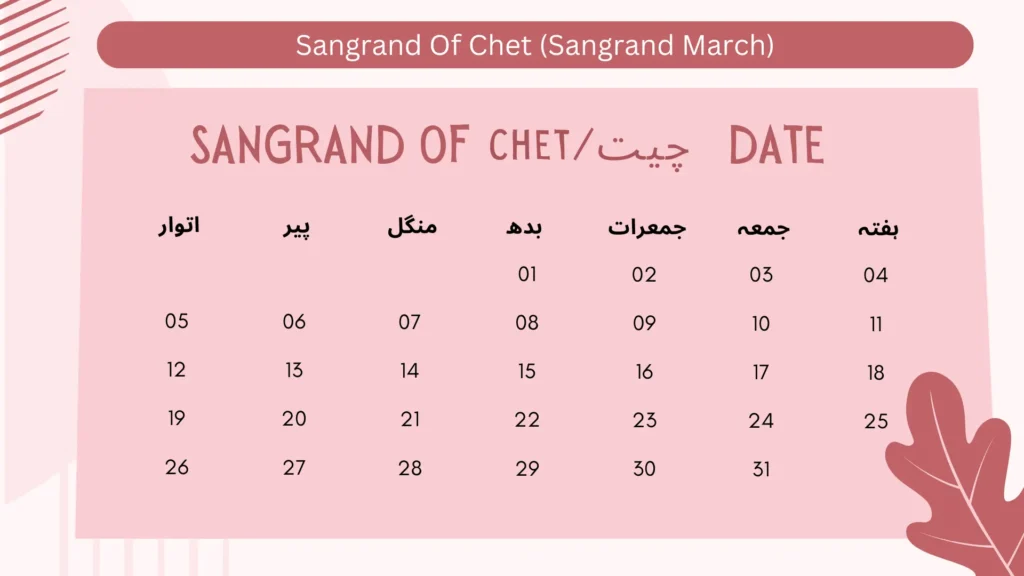Sangrand of Chet in March According to the Nanakshahi Samvat Calendar
The first day of the month of Chet is known as the Sangrand of Chet. It is the first Sangrand of the year, as given to us by Saheb Siri Guru Nanak Dev Ji and Siri Guru Arjan Dev Ji in their Bani of Baramaha.
On the 14th of March, there is the Sangrand of Chet, and in the Sangrand of Chet, Sikhs celebrate the New Year for the Guru Khalsa. Sahib Sri Guru Arjan Dev Ji and Sahib Sri Guru Nanak Dev Ji have given us the Bani of Barah Maah (Twelve Months), as mentioned in Sri Guru Granth Sahib Ji. Sri Guru Nanak Dev Ji has given this Bani in Tukhari Raag (a musical measure), and Sahib Sri Guru Arjan Dev Ji has given this Bani in Maaj Raag(another musical measure).
You can view the list of all Sangrand dates for each month in the current year. You can also see the English calendar dates for Sangrand in January, February, April, May, June, July, August, September, October, November, and December for the current year.

Teachings of Guru Arjan Dev Ji During Sangrand of Chet
Guru Arjan Dev Ji’s teachings were delivered at Manji Sahib, just outside of the Sarovar (sacred pool), where the Katha (religious discourse) of Sri Guru Granth Sahib Ji has been happening daily since the time of Guru Arjan Dev Ji. The seat of Guru Arjan Dev Ji, known as Devan (sacred assembly), is at Manji Sahib.
Key Figures in Sikh History
Sikhs such as Bhai Sarlo Ji, Baba Buddha Ji, and Bibi Mai Seva Ji, who were from the time of Guru Amar Das Ji, used to travel to Govindwal Sahib and Harmandir Sahib to perform Seva (selfless service).
Baba Buddha Ji’s Request
Baba Buddha Ji stood up at the start of the month and made a Benti (request) to Guru Arjan Dev Ji, saying that Guru Nanak Dev Ji has given us the Bani of Bara Maha in Tukhari Raag. Still, the deeper meanings need to be clarified and explained. Baba Buddha Ji requested Guru Arjan Dev Ji to bless them. Hence, Guru Arjan Dev Ji recited the second Bara Maha in Maaj Raag to make it easier for Gursikhs to understand.
Importance of Sangrand of Chet
Significance of the First Day
The first month in Bara Maha is Chet, the beginning of the New Year. So, on the first day of Chet (Sangrand of Chet), Sikhs celebrate the New Year according to their Guru’s teachings. The first day of the month is the Sangrand (first day of the month), and Sikhs celebrate Sangrand by coming together for Saad Sangat (holy congregation), where Guru Sahib Ji gives them teachings.
The Role of Sangrand
People sometimes question why Sikhs celebrate Sangrand, as it is often perceived as having nothing to do with Sikhi. Sangrand is simply the changing of the month. Like in Western countries or others where Sunday is a day of rest, people don’t necessarily work on Sundays, so they come together and participate in Sangat at the Gurdwara. Similarly, in the old days, the day of Sangrand, the first day of the month, would be when the Sangat (congregation) would come together for Saad Sangat.
Celebration Across Religions
Different religions may celebrate Sangrand in various ways. Still, in Gursikhi, they always participate in Saad Sangat, Seva, and Katha Kirtan (devotional singing and discourse) to celebrate their events. Sangrand is a day when they gather to mark the month’s change by participating in Saad Sangat and receiving teachings from their Guru.
Reflections on Bara Maha
Understanding the Teachings of Chet During Sangrand of Chet
Reflecting on Bara Maha from Guru Arjan Dev Ji, Sikhs consider the month of Chet. The first two Pangtiyan(lines) of this Baramaha part by Sri Guru Arjan Dev Ji say that in this month of Chet, Govind Aradiyah. Govind (protector of the world) means the protector, the sustainer of this world, the protector of the universe. In the month of Chet, Sikhs are instructed to Aradiyah (yearn for, call out, remember, and meditate on) Govind.
Experiencing Anand (Bliss) During Sangrand of Chet
By remembering the Almighty Lord, the universe’s protector, we receive Anand (bliss). Anand is faithful bliss when we have no duality or love for anything else but a pure love for Waheguru. Kanaa Anand refers to an extreme bliss that never fades away. So, in this month of Chet, you should remember the Almighty Lord Waheguru, and what you receive is that extreme bliss that takes you beyond duality and never disappears, nurturing true love and joy.
Types of Anand
There are different types of Anand. Bajjan Anand is a temporary bliss experienced during Simran (meditative chanting) and Sangat. Still, it fades when you move away. Kanaa Anand, however, is like the ocean—it never dries out, regardless of circumstances, always remaining, with the Kirpa (grace) continuously flowing.
Teachings for the Month of Chet (Sangrand of Chet)
The Deeper Meaning of Chet
Sahib Sri Guru Arjan Dev Ji tells Sikhs this month of Chet, Chet Govind Aradiyah, hove Anand Kanaa. If you remember the Almighty Lord Waheguru, the extreme bliss that never fades will remain with you. Chet also has a deeper meaning because these months of Bara Maha provide teachings for the months and 12 Avasthas(states of spiritual development). In this month of Chet, Chet translates further to human life, indicating that this human life is for Chet—to remember. Chet means to remember, Chaita Rakhna (keeping in remembrance).
The Purpose of Human Life
In this human life, we are here to remember, to Govind Aradiyah, we are here to remember the Almighty Lord. This is the opportunity in human life to recognize the Almighty Lord and break free from the 8.4 million birth and death life cycle. While we are in this human life form, we must strive to remember God. We start by whispering or speaking, “Waheguru, Waheguru.” If we don’t know any other Paath(prayers) or Bani (scripture), we can recite “Waheguru.” At work, we can whisper, “Waheguru, Waheguru,” so only we can hear it and not disturb those around us.
This Simran will develop within; eventually, we won’t need to move our tongues, as it will become internalized. Those Gursikhs who engage in this practice will understand how spirituality develops internally and that everything progresses naturally, allowing us to remember Waheguru constantly.
Achieving Bliss and Liberation During the Sangrand of Chet
The Path to Anand and Unity with the Lord
From there, we will experience that extreme bliss of breaking free from the 8.4 million birth and death life cycle and becoming one with the Almighty Lord. In this month of Chet, the New Year, we must remember the Almighty Lord, Akaal (the Timeless One), Waheguru, who protects the universe and all creation, including us. By remembering Him, we will gain extreme bliss. Additionally, if we remember Akaal Purakh (Timeless Being), Waheguru, the complete protector, the Almighty Lord, in this Chet, in this human life of Chet, and meditate upon Him, we will gain extreme bliss.
Conclusion
The teaching for the Sangrand of Chet and for our lives is to remember the Almighty Lord and attain extreme bliss because we will be freed from the birth-and-death life cycle and become one with the Almighty Lord. Let us hope and pray that Guru Sahib Ji blesses us and showers us with that Kirpa so that we can remember Him at all times and be freed from the birth-and-death life cycle, reuniting us with Him.
